Sixth generation of video game consoles
  |
| Part of a series on the |
| history of video games |
|---|
In the history of video games, the sixth-generation era (sometimes referred to as the 128-bit era; see "Bits and system power" below) refers to the computer and video games, video game consoles, and video game handhelds available at the turn of the 21st century which was from 1998 to 2008. Platforms of the sixth generation include the Sega Dreamcast, Sony PlayStation 2, Nintendo GameCube, and Microsoft Xbox. This era began on November 27, 1998 with the Japanese release of the Dreamcast, and it was joined by the PlayStation 2 in March 2000 and the GameCube and Xbox in 2001. The Dreamcast was discontinued in 2001, the GameCube in 2007, Xbox in 2009 and PlayStation 2 in 2013. Though the seventh generation of consoles started in November 2005 with the launch of the Xbox 360, the sixth generation did not end until January 2013, when Sony announced that the PlayStation 2 had been discontinued worldwide.[1]
Bit ratings for consoles largely fell by the wayside during this era, with the notable exceptions being the Dreamcast and PS2 promotions adverting 128-bit graphics at the start of the generation. The number of "bits" cited in console names referred to the CPU word size and had been used by hardware marketers as a "show of power" for many years. However, there was little to be gained from increasing the word size much beyond 32 or 64 bits because once this level was reached, performance depended on more varied factors, such as processor clock speed, bandwidth, and memory size.
The last official Dreamcast games were released in 2002 (North America and Europe) and 2007 (Japan). The last GameCube games were released in 2006 (Japan) and 2007 (North America and Europe). The last Xbox games were released in 2007 (Japan) and 2008 (Europe and North America). Pro Evolution Soccer 2014 was the last game released for PlayStation 2.[2] Due to the long lifespan of the PlayStation 2, which was available for 13 years, the sixth generation is the second longest generation of all time.
Home systems
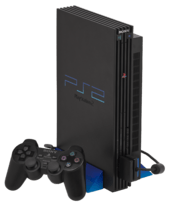
The Sony PlayStation 2[3][4][5] achieved sales dominance in this generation, becoming the best-selling console in history,[6] with over 150 million units sold as of February 2011.[7] The Microsoft Xbox had sold over 24 million units as of May 2006,[8][9] and the Nintendo GameCube had sold 22 million units as of September 2010.[10] The Sega Dreamcast, which arrived prior to all of the others and was discontinued in 2001, came in fourth with 9.13 million sold.[11]
The sixth generation began to end when the Xbox was succeeded by the Xbox 360 in late 2005. GameCube hardware was still being produced when the Wii was released in late 2006, but as of June 2008 has also been ceased. PlayStation 2 sales continued to be strong into November 2010,[12] due to the system's large software library, continuing software support, and affordable price.[13]
In February 2008, the PlayStation 2 outsold both the PlayStation 3 and Xbox 360 in the United States.[14][15] Games were still being produced for the PlayStation 2, Xbox, and Nintendo GameCube as of 2008, while Dreamcast games were officially discontinued in 2003. There were still a few games being produced for the Dreamcast in 2004, but they are essentially NAOMI arcade ports released only in Japan, with small print runs. The PlayStation 2 was still being produced after the launch of Xbox 360, Wii and PlayStation 3, making the sixth generation the second longest generation of all time.
Dreamcast
Sega's Dreamcast was the first console of the generation[16] and had several features to show an advantage from the competition, including Internet gaming as an optional feature through its built-in modem, and a web browser. Although consoles had these features before, the Dreamcast brought them to millions of homes. It was also the first home console to always display full SD resolution.
The console helped to restore Sega's reputation, which had been damaged by the earlier failures of the Sega Saturn, Sega 32X, and Mega-CD. Despite this, the Dreamcast was discontinued prematurely due to numerous factors. The impending and much-hyped PlayStation 2 slowed Dreamcast sales, mostly due to the fact that the PlayStation 2 had a built-in DVD player and a huge number of PS1 owners looking to upgrade to the new, backwards-compatible console. In addition, Sega's short-lived support/success of its post-Mega Drive products the Mega-CD, 32X and Saturn had left developers and customers skeptical, with some holding out to see whether the Dreamcast or PlayStation 2 would come out on top.
Sega's decision to implement a GD-ROM (though publicly advertised as a CD-ROM) for storage medium did save costs but it did not compare well against the PS2's much touted DVD capabilities. Sega was either unable or unwilling to spend the advertising money necessary to compete with Sony, which themselves took massive losses on the PlayStation 2 to gain market-share. With the announcements of the Xbox and GameCube in late 2000, Sega's console was considered by some to be outdated only two years after its release. The previous losses from the Saturn, 32X, and Sega/Mega-CD, stagnation of sales due to the PlayStation 2, and impending competition from Microsoft and Nintendo caused Sega's revenue to shrink and announce their intention on killing the system in early 2001, dropping the system entirely and leaving the console market in early 2004 in Japan and much earlier in other countries. Sega also announced it would shut down SegaNet, an online gaming community that supported online-capable Dreamcast titles. Due to user outcry over the decision, Sega delayed the service's closure by an additional 6 months.
PlayStation 2
The brand Sony had established with the original PlayStation was a major factor in the PlayStation 2's dominance, both in terms of securing a consumer base and attracting third party developers, with the gradual increase in one reinforcing the other. The PlayStation 2 was also able to play DVDs and was backwards-compatible with PlayStation games, which many say helped the former's sales. Sony Computer Entertainment secured licensing for key games such as Final Fantasy X, Grand Theft Auto III, and Metal Gear Solid 2: Sons of Liberty, enabling the PS2 to outperform its competitors' launches.
GameCube
Nintendo struggled with conflicting brand images, particularly the family-friendly one developed during the 1990s. Its arsenal of franchises and history in the industry, though earning it a loyal fan base, failed to give it an advantage against the Xbox and PlayStation 2 which captured audiences seeking 'Mature' titles of which Nintendo had fewer. Nintendo also made little headway into online gaming (releasing a small handful of online-capable games, the most popular of which was Phantasy Star Online, which was in fact a port of the Dreamcast game), instead emphasizing Game Boy Advance connectivity. As a result, the Nintendo GameCube failed to match the sales of its predecessor, the Nintendo 64. Nintendo did however rejuvenate its relationship with many developers, often working in close collaboration with them to produce games based upon its franchises, in contrast to the past where it was frequently seen as bullying developers. As a result, the Nintendo GameCube had more first and second party releases than its competitors, whose most successful titles were mainly products of third party developers.
Xbox
Although the Xbox had the formidable financial backing of Microsoft, it was unable to significantly threaten the dominance of the PlayStation 2 as market leader; however, the Xbox attracted a large fanbase and strong third-party support in the United States and Europe and became a recognizable brand amongst the mainstream. The Xbox Live online service with its centralized model proved particularly successful, prompting Sony to boost the online capabilities of the PlayStation 2. Xbox Live also gave the Xbox an edge over the GameCube, which had a near total lack of online games. The flagship of Xbox Live was the game Halo 2, which was the best selling Xbox game with over 8 million copies sold worldwide.[17][18]
Comparison
| Name | Dreamcast | PlayStation 2 | GameCube | Xbox |
|---|---|---|---|---|
| Manufacturer | Sega | Sony (SCE) | Nintendo | Microsoft |
| Image(s) | 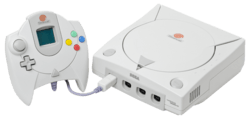 |
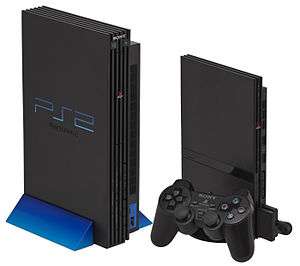 |
 |
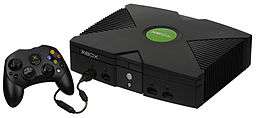 |
| An NTSC-J Dreamcast console, controller and VMU. On PAL consoles, the Dreamcast swirl was blue, and on NTSC-U it was red. | Left: An original model PlayStation 2 Right: A slimline PlayStation 2 with DualShock 2 controller and memory card. |
An indigo GameCube, controller and memory card | An Xbox console and "Type-S" controller | |
| Launch prices | US$199.99 (equivalent to $285.00 in 2016)[19] GB£199.99 (equivalent to £313.00 in 2016)[19] |
US$299.99 (equivalent to $413.00 in 2016) GB£299.99 (equivalent to £469.00 in 2016) |
US$199.99 (equivalent to $268.00 in 2016) GB£129.99 (equivalent to £191.00 in 2016)[20] €199.99[20] |
US$299.99 (equivalent to $402.00 in 2016) GB£299.99 (equivalent to £440.00 in 2016) €479.99 |
| Current price | N/A | N/A | N/A | N/A |
| Best-selling game | Sonic Adventure, 2.5 million (as of June 2006)[21] | Grand Theft Auto: San Andreas, 20.81 million (as of August 24, 2013) | Super Smash Bros. Melee, 7.5 million (as of August 24, 2013) | Halo 2, 8.49 million (as of August 24, 2013) |
| Release date | ‹See Tfd›
‹See Tfd›
‹See Tfd›
‹See Tfd›
|
‹See Tfd›
‹See Tfd›
‹See Tfd›
‹See Tfd›
|
‹See Tfd›
‹See Tfd›
‹See Tfd›
‹See Tfd›
|
‹See Tfd›
‹See Tfd›
‹See Tfd› |
| Discontinued | ‹See Tfd›
‹See Tfd›
‹See Tfd› |
‹See Tfd›
‹See Tfd›
|
2007[25] | |
| Accessories (retail) |
|
|
||
| CPU | 200 MHz SuperH SH-4 | 294 MHz MIPS "Emotion Engine" 299 MHz later models | 485 MHz PowerPC "Gekko" | 733 MHz x86 Intel Celeron/PIII Custom Hybrid |
| GPU | 100 MHz NEC/VideoLogic PowerVR CLX2 | 147 MHz "Graphics Synthesizer" | 162 MHz ATI "Flipper" | 233 MHz Custom Nvidia NV2A |
| RAM | Main RAM 16 MB SDRAM Video RAM 8 MB Sound RAM 2 MB |
Main RAM 32 MB SDRAM Video RAM 4 MB eDRAM Sound RAM 2 MB |
Main RAM 24 MB 1T-SRAM, 16 MB DRAM Video RAM 3 MB embedded 1T-SRAM |
64 MB unified DDR SDRAM |
| Audio | Stereo audio, with: | 5.1 Surround sound audio, with:
|
Stereo audio, with:
|
Stereo audio, with:
|
| Optical media | CD, 1.2 GB GD-ROM | DVD, CD | Nintendo GameCube Game Disc | DVD, CD |
| Video outputs | VGA (RGBHV), SCART (RGBS), s-video, composite | Component/d-terminal (YPBPR), VGA (RGBS; progressive scan games/PS2 Linux only), SCART (RGBS), s-video, composite | Component/d-terminal (YPBPR), SCART (RGBS; PAL consoles only), s-video (NTSC consoles only), composite | VGA (RGBHV), component (YPBPR), SCART (RGBS), S-Video, composite |
| Online service | Sega Net (2000–2002), Dreamarena (2000-2003) (can still be played using various private servers) | Non-unified service (2002–present), XLink Kai (2003–present) | Non-unified service (2003-2009) (can still be played using various private servers), XLink Kai (2003–present) | Xbox Live (2002–2010) XLink Kai (2003-present) |
| Backward compatibility | N/A | PlayStation | Game Boy, Game Boy Color, Game Boy Advance with Game Boy Player attachment | N/A |
| System software | SegaOS, Windows CE, KallistiOS | Proprietary OS, PS2 Linux | Proprietary OS, Gamecube Linux | Xbox Music Mixer DVD Playback Kit, Xbox Linux |
| Consumer programmability | Homebrew possible via KallistiOS, Windows CE, Katana (the latter two are illegal in the homebrew community) | Yabasic software and limited Linux OS. Homebrew also possible via both modchips and softmods. | Homebrew possible via SD card adapters and SD media launchers | Via Softmods and/or modchips; modified Windows CE 2.x, Linux |
Worldwide sales standings
| Console | Units sold |
|---|---|
| PlayStation 2 | 155 million (as of March 31, 2012)[26][27] |
| Xbox | 24 million (as of May 10, 2006)[8][9] |
| GameCube | 22 million (as of September 30, 2010)[10] |
| Dreamcast | 9.13 million (as of September 6, 2002)[11] |
Other consoles
- Mass market
These consoles were created for the mass market, like the 4 consoles listed above. These, however, are less notable, never saw a worldwide release, and/or have sold particularly poorly, and are therefore listed as 'Other'.
-

The Nuon was a hybrid DVD player/gaming system released in 2000, that had a very small game library.
-
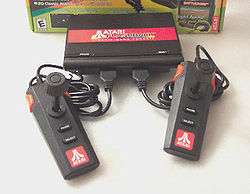
The Atari Flashback, the "plug and play" version of the Atari 2600 and 7800 Released in 2004.
-
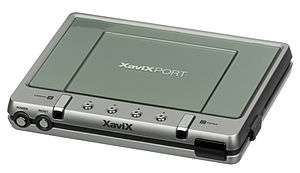
The XaviX is the video gaming base console for the XaviX Interactive System, released by SSD COMPANY LIMITED in 2004.
Bits and system power
Bit ratings for consoles largely fell by the wayside after the fifth generation (32/64-bit) era. The number of "bits" cited in console names referred to the CPU word size, but there was little to be gained from increasing the word size much beyond 32 bits; performance depended on other factors, such as central processing unit speed, graphics processing unit speed, channel capacity, data storage size, and memory speed, latency, and size.
The importance of the number of bits in the modern console gaming market has thus decreased due to the use of components that process data in varying word sizes. Previously, console manufacturers advertised the "n-bit talk" to over-emphasize the hardware capabilities of their system. The Dreamcast and the PlayStation 2 were the last systems to use the term "128-bit" in their marketing to describe their capability.
It is not easy to compare the relative "power" of the different systems. Having a larger CPU word size does not necessarily make one console more powerful than another. Likewise, the operating frequency (clock rate, measured in terms of Hertz) of a system's CPU is not an accurate measure of performance either, except between systems of the same or similar architecture).
The Microsoft Xbox uses a 32-bit (general purpose) CISC x86 architecture CPU, with an instruction set equal to that of the Coppermine core Mobile Celeron, though it has less cache (128 kB) than the PC equivalent. It has 64 MB RAM (shared) and runs at 733 MHz. Because the Pentium 3 introduced SSE, the Xbox also had 128-bit SIMD capabilities. Its NV2A GPU, which is very similar to the GeForce 3 Series of desktop GPUs, makes it the only console in its time with traditional vertex and pixel shaders.[28]
The Nintendo GameCube's IBM Gekko PowerPC CPU runs at 485 MHz, while its "Flipper" graphics processor is comparable to the original ATI Radeon, and it has 43 MB of non-unified memory (24 MB of 1T-SRAM, 3 MB embedded 1T-SRAM, and 16 MB DRAM). The GameCube supports Dolby Pro Logic II.[29]
The PlayStation 2's CPU (known as the "128-bit Emotion Engine") has a 64-bit core with a 32-bit FPU coupled to two 128 bit Vector Units, The hybrid R5900 CPU is based on MIPS architecture,The PS2 also has an internal 10 Channel DMA Bus which is fully 128 bits wide, Paths between the Emotion Engine, RAM and the Graphics synthesizer (GS) are also 128 bits wide. The PS2's unique hardware arrangement with no less than 10 processing units were difficult to come to grips with. Many developers struggled initially with programming the hardware. The PS2's Graphics Synthesizer (GS) has fast dedicated video memory, though it is limited in the amount of data it can hold, The 10 Channel 128 bit wide DMA bus could pump data to GS Memory as fast as the screen could update. Consequently, With the main memory being limited to 32mb, many of the PS2's games have reduced textures compared with versions for other consoles. It also does not have a hardware dedicated transform and lighting unit like the ones found in the Xbox and GameCube GPUs. However the PS2's design allows a remarkable degree of flexibility and choice, For example, Program control and general arithmetic could be handled by the CPU, While the Vector Units 0 and 1, could provide parallel processing of physics, clipping and transform and lighting to the scene. The Vector units were noted to be so versatile that Shadow of The Colossus used one of the vector units to do full Pixel shading for the fur of the Collossi.
The Dreamcast has a 64-bit double-precision superscalar SuperH-4 RISC Central processing unit core with a 32-bit integer unit using 16-bit fixed-length instructions, a 64-bit data bus allowing a variable width of either 8, 16, 32 or 64-bits, and a 128-bit floating-point bus.[30] The PowerVR 2DC CLX2 chipset uses a unique method of rendering a 3D scene called Tile Based Deferred Rendering (TBDR): while storing polygons in triangle strip format in memory, the display is split into tiles associated with a list of visibly overlapping triangles onto which, using a process similar to ray tracing, rays are cast and a pixel is rendered from the triangle closest to the camera. After calculating the depths associated with each polygon for one tile row in 1 cycle, the whole tile is flushed to video memory before passing on to render the next tile. Once all information has been collated for the current frame, the tiles are rendered in turn to produce the final image.
Handheld systems
During the sixth generation era, the handheld game console market expanded with the introduction of new devices from many different manufacturers. Nintendo maintained its dominant share of the handheld market with the release in 2001 of the Game Boy Advance, which featured many upgrades and new features over the Game Boy. Two redesigns of this system followed, the Game Boy Advance SP in 2003 and the Game Boy Micro in 2005. Also introduced were the Neo Geo Pocket Color by SNK in 1998 and Bandai's WonderSwan Color, launched in Japan in 1999. South Korean company Game Park introduced its GP32 handheld in 2001, and with it came the dawn of open source handheld consoles. The Game Boy Advance line of handhelds has sold 81.51 million units worldwide as of September 30, 2010.[10]
A major new addition to the market was the trend for corporations to include a large number of "non-gaming" features into their handheld consoles, including cell phones, MP3 players, portable movie players, and PDA-like features. The handheld that started this trend was Nokia's N-Gage, which was released in 2003 and doubled primarily as a mobile phone. It went through a redesign in 2004 and was renamed the N-Gage QD. A second handheld, the Zodiac from Tapwave, was released in 2004; based on the Palm OS, it offered specialized gaming-oriented video and sound capabilities, but it had an unwieldy development kit due to the underlying Palm OS foundation.
With more and more PDAs arriving during the previous generation, the difference between consumer electronics and traditional computing began to blur and cheap console technology grew as a result. It was said of PDAs that they were "the computers of handheld gaming" because of their multi-purpose capabilities and the increasingly powerful computer hardware that resided within them. This capability existed to move gaming beyond the last generation's 16-bit limitations; however, PDAs were still geared towards the typical businessman, and lacked new, affordable software franchises to compete with dedicated handheld gaming consoles.
Handheld comparison
| Name | Game Boy Advance / Advance SP / Micro | N-Gage / QD | Tapwave Zodiac |
|---|---|---|---|
| Manufacturer | Nintendo | Nokia | Tapwave |
| Console | 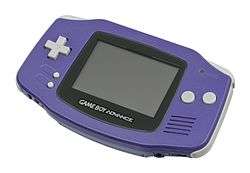  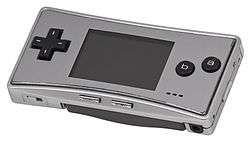
|
 
|
 |
| Release dates | Game Boy Advance: ‹See Tfd›
‹See Tfd›
‹See Tfd›
‹See Tfd›
‹See Tfd›
‹See Tfd›
‹See Tfd›
‹See Tfd›
|
N-Gage: October 7, 2003 N-Gage QD: May 26, 2004 |
Zodiac: ‹See Tfd›
‹See Tfd›
|
| Discontinued | ‹See Tfd›
‹See Tfd›
‹See Tfd›
|
2006 | July 26, 2005 |
| Logos |  |
||
| Launch prices | GBA:
GBA SP:
GB Micro:
|
N-Gage:
N-Gage QD:
|
Zodiac:
Zodiac 2:
|
| Media | Game Boy Advance cartridge | MultiMediaCard (MMC) | |
| Best-selling game | Pokémon Ruby and Sapphire, 13 million combined (as of November 25, 2004)[31] | ? | ? |
| Accessories (retail) |
|
||
| OS | Symbian S60 | Palm OS | |
| CPU | 16.8 MHz, 32-bit, ARM7TDMI with embedded memory | 104 MHz, 32-bit, RISC based on ARM9 series | 200 MHz, 32-bit, Motorola i.MX1 ARM9 processor |
| Memory | 32 kilobyte + 96 kilobyte VRAM (internal to the CPU), 256 kilobyte WRAM (outside the CPU) | 16 megabyte RAM, 16 megabyte ROM (3.4 MB accessible for storage) | |
| Audio | Stereo audio, with:
|
Stereo audio (using headphones), with:
|
16-bit PCM stereo (can play back most audio codecs) |
| Interface |
|
|
|
| Dimensions | GBA: 144.5 × 24.5 × 82 mm (5.69 × 0.96 × 3.2 inches) GBA SP: 84 × 82 × 24.4 mm (3.3 × 3.23 × 0.96 inches) GB Micro: 50 × 101 × 17.2 mm (2 × 4 × 0.7 inches) |
N-Gage QD: 70 mm (2.8 in) (h) 134 mm (5.3 in) (w) 20 mm (0.79 in) (d) N-Gage QD: 118 mm (4.6 in) (w) 68 mm (2.7 in) (h) 22 mm (0.87 in) (d) |
142 mm (5.6 in) (w) 79 mm (3.1 in) (h) 14 mm (0.55 in) (d) |
| Weight |
GBA: 140 g (4.9 oz) GBA SP: 142 g (5.0 oz) GB Micro: 80 g (2.8 oz) |
N-Gage: 137 g (4.8 oz) N-Gage QD 143 g (5.0 oz) |
180 g (6.3 oz) |
| Online service | N-Gage Arena | ||
| Backward compatibility | Game Boy, Game Boy Color (GBA, GBA SP only) | N/A | N/A |
| Resolutions | 240 × 160 | 176 × 208 | 480 × 320 |
| I/O | |||
| Storage | 3.4 MB internal storage, MMC | SD card expansion | |
| Battery life | GBA: 15 hours GBA SP: 10 hours continuous play with light on, 18 hours with light off GB Micro: 5 hours with top brightness and sound, 8 hours with both features on default |
N-Gage: 2 hours continuous play N-Gage QD: 4 hours continuous play |
4 hours continuous play, 6 hours of continuous audio player |
| Units sold (all models combined) | Worldwide: 81.51 million (as of September 30, 2010) Japan: 16.96 million |
Worldwide: 3 million (as of July 30, 2007) | Worldwide: 200,000 |
Note: First year of release is the first year of the system's worldwide availability.
Other handhelds
-

Neo Geo Pocket Color (1999)
-

Pokémon Mini (2001)
-
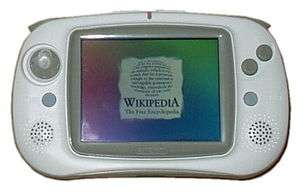
GP32
Released in 2001, discontinued around 2005 – South Korea only -
V.Smile Pocket (2005) Created by VTech
Sales
| Console | Units sold |
|---|---|
| Game Boy Advance (figure includes GBA SP and Game Boy Micro) |
81.51 million[10] |
| N-Gage | 3 million[32] |
| Tapwave Zodiac | less than 200,000 units[33] |
| GP32 | 30,000 |
Trends
Market convergence
Major publishers such as Activision, Electronic Arts, and Ubisoft adopted a cross-platform strategy, releasing versions of their games for PC, all major consoles, and in some cases, handhelds as well. The sixth generation was the first to help console and computer software grow closer together as well as outperform the arcade market in features, graphics and business. The Dreamcast, which had an official Windows CE Development Kit to help porting games from PCs to Dreamcast, and the Xbox, which was made from off-the-shelf PC parts and hosted many PC ports, factored into this also.
Controversial games
While the sixth generation was not the first to have its share of controversial games, this generation was noted to have extensive criticism by public figures of "objectionable" content in gaming such as sex, crime, violence, profanity, drug use, and social propaganda as well as topics of debate such as religion, politics and economics.
The sixth generation was also notable because it saw the continuation of lawmakers taking actions against the video game industry. The most famous were Rockstar Games' Manhunt and Grand Theft Auto games (Grand Theft Auto III and Grand Theft Auto: Vice City) facing lawsuits over alleged racial slurs and influencing minors to commit crimes, while Grand Theft Auto: San Andreas was briefly given an adult rating and removed from most stores over the availability of an abandoned sex mini-game using the Hot Coffee mod.
The sixth generation also coincided with the September 11 attacks in New York City and the Pentagon, which had a huge impact on the entertainment industry, including the video game industry; in the subsequent market climate, multiple games were edited in response to the sensitivity surrounding the event. Prior to its release, Metal Gear Solid 2: Sons of Liberty depicted a submersible mobile fortress hijacked by terrorists destroying a good portion of Manhattan in view of the twin towers (this can be found in the "Document of Metal Gear Solid 2" making-of feature). Similarly, several undisclosed modifications were made in Grand Theft Auto III, including a change to the police cars' color scheme (the old scheme resembled that of NYPD's older blue and white design). The Dreamcast game Propeller Arena was never officially released, possibly due to a certain level which was visually very similar to the September 11 attacks.
Emulation and retro gaming
Because of the increased computing power of video game consoles and the widespread usage of emulators, the sixth generation saw the rise of console emulation and retro gaming on a vast scale. Many games for older systems were updated with superior graphics or sound and re-released for current consoles. Commonly emulated games included those released for the Nintendo Entertainment System, the Super Nintendo Entertainment System, the Mega Drive/Genesis, the PlayStation (the PS2 can play PS1 games natively), and the Nintendo 64.
Also during this generation, the computing power of handheld consoles became capable of supporting games made for some of the earliest gaming consoles and several companies released remakes of classic games for the handhelds. Nintendo introduced a line of NES and SNES games for its Game Boy Advance handheld, including remakes such as Final Fantasy I & II: Dawn of Souls and Nintendo's Metroid: Zero Mission. Also, an increasing number of third-party developers, including Midway Games, Capcom, Namco, Atari, and Sega, released anthology collections of some of their old games. Additionally, many video games and video game series that were originally confined to Japan were released in North America and Europe for the first time.
Rise of online gaming
Online gaming, which in previous generations had been almost an exclusive domain of PC games, became more prominent in video game consoles during this generation. The Dreamcast initiated this change with its built in modem, internet browsing software, and ability to play certain games online. The PlayStation 2, Xbox and GameCube also offered online gaming, though their approaches and commitment to it varied greatly. The Xbox offered an integrated service called Xbox Live that cost $50 per year and was only compatible with a broadband internet connection. Its ability to connect gamers for online multi-player matches was a considerable factor in allowing the Xbox to gain a foothold in the western market, especially in the first-person shooter genre. The PlayStation 2 left its online gaming service up to each individual game publisher, and though it was free to use, it was not always an ideal experience, especially with games published by small developers. The SOCOM series was one of the most popular online competitive games for the PS2. The GameCube did not offer online play for any of its first-party titles, with only Sega's Phantasy Star Online series and Homeland making official use of the console's online capabilities. In addition, online capability was not out-of-the-box; an adapter was needed to hook the GameCube to the internet.
Mergers
Many game publishing companies with a long established history merged with their competitors: Microsoft bought second-party developer Rare in 2002; Square merged with Enix to form Square Enix in 2003 and then later bought Taito; Sega merged with Sammy to form Sega Sammy Holdings in 2004; Konami bought a majority share of Hudson Soft; Namco merged with Bandai to form Bandai Namco Holdings in 2006.
Software
Milestone titles
- Jet Set Radio (DC) by Smilebit and Sega received universal acclaim for its arcade-style gameplay, up-tempo music and cel-shaded visuals. It popularized the use of cel-shaded visuals in video games.
- Final Fantasy X (PS2) by Square (now Square Enix) refined many elements found in its predecessors, adding a completely different battle system. Within four days of its release in Japan the game had sold over 1.4 million copies in pre-orders, setting the record for the fastest-selling console RPG.[34]
- Forza Motorsport (Xbox) by Turn 10 Studios and Microsoft Studios received universal critical acclaim[35] and is considered to have set a new standard for the racing genre.[36][37][38]
- God of War and God of War II (PS2) by Santa Monica Studio and Sony Computer Entertainment (SCE) were both released to universal acclaim from critics for their gameplay, graphics and story.
- Grand Theft Auto III, Vice City, and Grand Theft Auto: San Andreas (PS2, Xbox, PC) by Rockstar popularized "sandbox" style gameplay in an urban crime setting, which has since been widely imitated. In addition, it brought violence and other potentially objectionable content in video games back into the mainstream spotlight, thus reviving the video game controversy.
- Half-Life 2 (PC, Xbox) by Valve Corporation was praised for its advanced physics, animation, sound, AI, graphics, gameplay, and narrative, and was named Game of the Decade at the Spike Video Game Awards.
- Halo: Combat Evolved (PC, Xbox) by Bungie and Microsoft Studios was by far the most successful launch title for the Xbox. Halo 2 set records as the fastest grossing release in entertainment history [39] and was still very successful on the Xbox Live online gaming service until support was dropped in April 2010.
- The Legend of Zelda: The Wind Waker (GC) by Nintendo EAD and Nintendo remains one of the most critically acclaimed games of the generation. Critics praised the vivid artistry and timeless gameplay. It has a score of 96% on Metacritic, and is the fourth game to obtain a perfect score from video game reviewer Famitsu. Likewise, The Legend of Zelda: Twilight Princess (GC) proved to be another important title in the series released this generation. The title is perhaps best remembered for the excitement caused by its announcement trailer at E3 2004. It was released to widespread critical acclaim with an average of 96% on Metacritic. The game drew lots of praise for its scale and cinematic style with many reviewers declaring it the best game in the series.[40] Likewise, it was seen as a transitional title being released on both the Gamecube and Wii - which resulted in it being the best selling title in the series since Ocarina of Time.
- Metal Gear Solid 2: Sons of Liberty (PS2, Xbox) and Metal Gear Solid 3: Snake Eater (PS2) by Konami Computer Entertainment Japan and Konami improved upon the stealth genre by adding many new abilities, and for the first time in its respective genre made the surroundings nearly completely interactive. Both games achieved widespread critical acclaim, as they improved many elements from their predecessor.
- Metroid Prime (GC) by Retro Studios and Nintendo is one of the generation's highest-rated titles, with a score of 96.3 on GameRankings and a 97 on Metacritic.[41][42]
- NFL 2K1 (DC) by Visual Concepts and Sega was the first football game to feature online play.[43]
- Phantasy Star Online (DC, GC, Xbox) by Sonic Team and Sega, the first console MMORPG, has been cited as one of the most groundbreaking and influential games of the generation.[44]
- Pokémon Ruby and Sapphire (GBA) Despite the fact that the games received some backlash due to connectivity issues with the older games, these games still received positive reception for adding much more innovation to Pokémon series. Eventually becoming the best selling games for the Game Boy Advance.[45][46] Selling roughly over 16.22 million copies worldwide as of October 2013.[47]
- Resident Evil 4 (GC, PS2) by Capcom Production Studio 4 and Capcom revamped the franchise in a new, more action-oriented direction. It remains one of the highest rated games of the generation.
- Rez (DC, PS2) by United Game Artists and Sega received significant critical acclaim,[48][49] being cited as one of the greatest videogames ever made[50][51] and a significant example of videogames as art.[52]
- Shadow of the Colossus (PS2) by Team Ico and SCE has been frequently cited as an example of videogames as art.[53][54][55]
- Shenmue (DC) by Sega AM2 and Sega is regarded as a major step forward for 3D open-world gameplay,[56][57][58][59][60] introduced the quick time event mechanic in its modern form,[61] and has been widely cited as one of the best and most influential games ever made.[62][63][64][65]
- SoulCalibur (Arcade, DC) by Project Soul and Namco is the first fighting game on any platform to have ever received a perfect 10.0 rating from IGN[66] and GameSpot[67] and also a perfect 40/40 (second of only fifteen games)[68] from Japanese gaming magazine Famitsu. Soul Calibur II was a bestseller on all three consoles it was released, and was notable for featuring exclusive characters for every version released.
- Star Wars: Knights of the Old Republic (PC, Xbox) by Bioware and LucasArts has been cited as one of the best games of the generation[69] and greatest games of all time.[70][71]
- Super Mario Sunshine (GC) by Nintendo Entertainment Analysis & Development (Nintendo EAD) and Nintendo is the highest-rated 3D platformer of the generation with a Metacritic score of 92/100.[72]
- Super Smash Bros. Melee (GC) by Hal Laboratory and Nintendo went on to become one of the most popular and most played games on the GameCube console.
- Tekken Tag Tournament (PS2) was a launch title for the PlayStation 2, and was regarded as one of the best ever,[73] and is also considered one of if not the most significant entry to the Tekken series. Throughout the sixth generation, Tekken Tag was the fighting game of choice for many tournaments. The game was also praised for its graphical leap from the arcade on to the then, new generation of consoles, on the PlayStation 2.[74]
- Virtua Fighter 4 (Arcade, PS2) by Sega AM2 and Sega received universal critical acclaim, with a Metacritic score of 94/100, and is considered to have set a new standard for 3D fighting games.[75][76]
See also
References
- ↑ "PlayStation 2 manufacture ends after 12 years". The Guardian. January 4, 2013. Retrieved January 6, 2013.
- ↑ "The Last PS2 Game to Launch for the System Might not be FIFA 14 as PES 2014 is Confirmed for PS2 & PSP". PlayStation LifeStyle. Retrieved December 10, 2015.
- ↑ "PlayStation 2: PlayStation 2 System Specs at Ps2Fantasy.com". Retrieved December 10, 2015.
- 1 2 "Console Specs". Retrieved December 10, 2015.
- ↑ "The Dreamcast & PlayStation 2 Comparison Page.". Retrieved December 10, 2015.
- ↑ "SONY COMPUTER ENTERTAINMENT ASIA STARTS ITS PLAYSTATION BUSINESS IN REPUBLIC OF INDONESIA". SCEI. January 8, 2010. Retrieved February 13, 2010.
- ↑ "PLAYSTATION 2 SALES REACH 150 MILLION UNITS WORLDWIDE". Sony Computer Entertainment. February 14, 2011. Retrieved July 2, 2012.
- 1 2 "Gamers Catch Their Breath as Xbox 360 and Xbox Live Reinvent Next-Generation Gaming". Xbox.com. May 10, 2006. Archived from the original on July 9, 2007. Retrieved July 2, 2012.
- 1 2 "Xbox". A Brief History of Game Console Warfare. BusinessWeek. September 8, 2007. Retrieved July 2, 2012.
- 1 2 3 4 "Consolidated Sales Transition by Region" (PDF). Nintendo. October 27, 2010. Archived (PDF) from the original on November 16, 2010. Retrieved November 3, 2010.
- 1 2 Zackariasson, Peter; Wilson, Timothy L.; Ernkvist, Mirko (2012). "Console Hardware: The Development of Nintendo Wii". The Video Game Industry: Formation, Present State, and Future. Routledge. p. 158. ISBN 978-1138803831.
- ↑ Antonucci, Michael (November 15, 2007). "NPD's October video-game sales data, part 1". Mercury News. Retrieved December 3, 2007.
- ↑ Lewis, Nick (December 19, 2007). "Gaming's best releases promise hours of fun – and mayhem". Calgary Herald. Retrieved December 19, 2007.
- ↑ Shiau, Brian (March 13, 2008). "the simExchange – February 2008 NPD Data | The Video Game Prediction Market". Simexchange.com. Retrieved June 30, 2013.
- ↑ Luis, J. (February 26, 2014). "Sales Charts – February 2008". GAMbIT Magazine. Archived from the original on May 3, 2015. Retrieved May 11, 2015.
- ↑ Kent, Steven L. (February 18, 2004). "PlayStation 2 Timeline". GameSpy. IGN. p. 2. Archived from the original on March 8, 2008. Retrieved March 3, 2008.
1998 – November 27: Sega initiates the next generation of game consoles by launching Dreamcast in Japan...
- ↑ Chris Morris (May 9, 2006). "Grand Theft Auto, Halo 3 headed to Xbox 360". CNN. Retrieved November 24, 2007.
- ↑ Asher Moses (August 30, 2007). "Prepare for all-out war". The Sydney Morning Herald. Retrieved November 24, 2007.
- 1 2 "BBC – Sega Dreamcast to spark price war". BBC. April 16, 1959. Retrieved January 16, 2011.
- 1 2 "BBC – GameCube gets midnight launch". BBC. May 2, 2002. Retrieved November 12, 2011.
- ↑ Daniel Boutros (August 4, 2006). "sega smash pack". A Detailed Cross-Examination of Yesterday and Today's Best-Selling Platform Games. Gamasutra. Retrieved November 24, 2007.
- ↑ Sam Pettus, David Munoz, Kevin Williams, Ivan Barroso (2013). Service Games: The Rise and Fall of SEGA: Enhanced Edition. p. 455. ISBN 9781311080820.
- ↑ "BBC News - Sony stops production of PlayStation 2". Bbc.co.uk. December 31, 2012. Retrieved June 30, 2013.
- ↑ "PlayStation 2 manufacture ends after 12 years". Famitsu. January 31, 2013. Retrieved January 6, 2013.
- ↑ "GameCube gets vasectomy; no longer reproducing". Joystiq. December 31, 2009. Retrieved November 3, 2007.
- ↑ "Slimmer, Lighter PlayStation 3, new PlayStation Network services, plenty of content and a great value price" (PDF) (Press release). Sony Computer Entertainment. August 18, 2009. p. 2. Archived from the original (PDF) on April 20, 2013. Retrieved February 24, 2013.
- ↑ "PlayStation2 Worldwide Hardware Unit Sales". Sony Computer Entertainment. Archived from the original on September 21, 2013. Retrieved February 23, 2013.
- ↑ AnandTech.com: Hardware Behind the Consoles – Microsoft's Xbox vs. Sony PlayStation 2, November 21, 2001
- ↑ AnandTech.com: Hardware Behind the Consoles – Nintendo GameCube vs. Sony PlayStation 2 vs. Microsoft Xbox, December 7, 2001
- ↑ Technology Partner – Design Solutions from Hitachi Semiconductor (America) Inc.: SH7750 (SH-4 Series) MPU (November/December 1997)
- ↑ "Consolidated Financial Statements" (PDF). Nintendo. November 25, 2004. p. 4. Retrieved November 11, 2007.
- ↑ Blake Snow (July 30, 2007). "The 10 Worst-Selling Handhelds of All Time". GamePro. p. 1. Archived from the original on October 12, 2007. Retrieved December 3, 2008.
- ↑ Blake Snow (July 30, 2007). "The 10 Worst-Selling Handhelds of All Time". GamePro. p. 2. Archived from the original on October 13, 2007. Retrieved December 3, 2008.
- ↑ "Final Fantasy X Sells Like Crazy; World Not Shocked - PS2 News at IGN". Ps2.ign.com. Retrieved August 15, 2012.
- ↑ "Forza Motorsport". Metacritic. Retrieved March 3, 2012.
- ↑ Perry, Douglass (May 4, 2005). "Forza Motorsport". IGN. Retrieved March 4, 2012.
- ↑ Chou, Che (May 3, 2005). "Forza Motorsport". 1UP.com. Retrieved March 4, 2012.
- ↑ Fischer, Russ (May 3, 2005). "Forza Motorsport". GameSpy. Retrieved March 4, 2012.
- ↑ "'Halo 2' clears record $125 million in first day | CNET News.com". News.cnet.com. Retrieved June 30, 2013.
- ↑ "The Legend of Zelda: Twilight Princess". Metacritic. Retrieved December 10, 2015.
- ↑ "Metroid Prime on GameRankings". Retrieved March 11, 2011.
- ↑ "Metroid Prime on Metacritic". Retrieved March 11, 2011.
- ↑ Cork, Jeff (November 16, 2009). "Game Informer's Top 100 Games of All Time (Circa Issue 100)". Game Informer. Retrieved January 18, 2014.
- ↑ Parish, Jeremy (February 2010). "Phantasy Star Online". The Decade That Was: Essential Newcomers - We close our look back at the the [sic] past 10 years with five revolutionary new games. 1UP.com. p. 2. Retrieved September 23, 2011.
- ↑ Harris, Craig. "Pokemon Sapphire Version". IGN. Retrieved 17 March 2003.
- ↑ Harris, Craig. "Pokemon Ruby Version". IGN. Retrieved 17 March 2003.
- ↑ Rose, Mike. "Pokemon X & Y sell 4M copies in first weekend". Gamasutra. Retrieved 15 October 2013.
- ↑ Anon. (November 29, 2001). "Rez Review". Edge. Future plc. Retrieved November 18, 2012. Originally published in Edge issue 105, Christmas 2001.
- ↑ Simon Parkin (January 30, 2008). "Reviews = Rez HD // Xbox 360". Eurogamer.
- ↑ Sam Kennedy (January 29, 2008). "Rez HD (Xbox 360)". 1UP.com.
- ↑ Edge Staff (March 13, 2012). "The Untouchables: Rez". Edge Magazine. Retrieved January 17, 2014.
- ↑ "The Art of Video Games Voting Results" (PDF). Smithsonian American Art Museum. May 5, 2011. Retrieved May 27, 2011.
- ↑ Edge Presents The 100 Best Videogames. Future Publishing. 2007. p. 146.
- ↑ Ciccoricco, Dave. (2008). "'Play, Memory': Shadow of the Colossus and Cognitive Workouts". In Ennslin, A. and Bell, A. New Perspectives on Digital Literature. Dichtung Digital, Special Edition.
- ↑ "Okay, kids, play on my lawn". Chicago Sun-Times. Archived from the original on August 11, 2010.
- ↑ Scott Sharkey. "Top 5 Underappreciated Innovators: Five genre-defining games that didn't get their due". 1UP.com. Retrieved April 1, 2011.
- ↑ Brendan Main, Lost in Yokosuka, The Escapist
- ↑ Shenmue: Creator Yu Suzuki Speaks Out, GamesTM
- ↑ Yu Suzuki Archived February 4, 2012, at the Wayback Machine., IGN
- ↑ "The Disappearance of Yu Suzuki: Part 1". 1Up.com. Retrieved December 10, 2015.
- ↑ Adam LaMosca, On-Screen Help, In-Game Hindrance, The Escapist
- ↑ Readers' Picks Top 100 Games: 81-90 Archived November 3, 2013, at the Wayback Machine., IGN, 2006
- ↑ Greatest Games of All Time, Game, May 22, 2008
- ↑ 42: Shenmue, Empire, accessed February 25, 2011
- ↑ Furfari, Paul (August 2010). "15 Games Ahead of Their Time". 1UP.com. p. 2. Retrieved September 26, 2011.
- ↑ "Soulcalibur Review". IGN. Retrieved June 30, 2013.
- ↑ "Soul Calibur for Dreamcast Review – Dreamcast Soul Calibur Review". Gamespot.com. September 8, 1999. Retrieved June 30, 2013.
- ↑ "'''Gamespot''' "SSBB gets perfect score from Famitsu" ''includes list of perfect score recipients in order''". Gamespot.com. March 9, 2008. Retrieved June 30, 2013.
- ↑ "Best Games and Movies of 2000 - 2009". IGN. Retrieved May 22, 2011.
- ↑ Game Informer Issue #200 November 2010
- ↑ "All-TIME 100 Video Games". Time. Time Inc. November 15, 2012. Archived from the original on November 15, 2012. Retrieved November 15, 2012.
- ↑ "Super Mario Sunshine reviews". Metacritic. Retrieved January 22, 2014.
- ↑ Steven Hopper (November 23, 2011). "Tekken Hybrid Review". IGN. Retrieved December 10, 2015.
- ↑ Jeff Gerstmann. "Tekken Tag Tournament Review". GameSpot. Retrieved December 10, 2015.
- ↑ "Virtua Fighter 4". Metacritic. Retrieved December 10, 2015.
- ↑ Game Informer, May 2002, p.78: "Underneath its silky shine is a feast of fighting goodies that will change everything you have ever come to expect from this genre." cf. Game Informer, January 2004, p.64: "Absolutely ingenious....The most balanced and challenging fighting game the world has ever seen."
